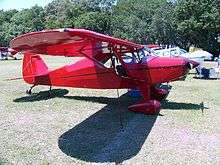Piper PA-16 Clipper
| PA-16 Clipper | |
|---|---|
 | |
| Piper PA-16 Clipper at the Short Wing Piper Convention in Kingston, Ontario on 6 July 2006 | |
| Role | PA-16 Clipper |
| Manufacturer | Piper Aircraft |
| First flight | 1947 |
| Introduction | 1949 |
| Produced | only in 1949 |
| Number built | 736 |
| Unit cost |
USD$2995 (in 1949) |
| Variants | Piper PA-20 Pacer |

The Piper PA-16 Clipper is an extended fuselage model of the PA-15 Vagabond.[1] Both models were designed in 1947 for the same reason - Piper Aircraft found itself in dire financial straits and needed to create new, competitive models using existing parts and tooling. The result was the Vagabond, essentially a side-by-side version of the tandem J-3 Cub credited with saving the company.[2]
Development
The PA-16 Clipper is a stretched and refined version of the Vagabond intended to seat four people[1] (or "two-and-a-half to three" as often told by Clipper pilots). It is equipped with an extra wing tank, added doors to accommodate the new seating, and a Lycoming O-235, the same engine that would later power the Cessna 152. The PA-16 Clipper retained the control sticks that had up to that point been common in aircraft derived from the "Cub" family.
Cost
In 1949, the Clipper sold for $2995. The average four place airplane on the market at that time cost over $5000. Only 736 Clippers were built in the one year of production before Piper changed to the Piper PA-20 Pacer.[3]
Nomenclature
Pan Am Airlines, who traditionally called its famous luxury airliners "Clippers", took offense at Piper using the name for their light aircraft. As a result of this pressure Piper further refined the model, adding wing flaps, further fuel tanks and replaced the control sticks with yokes. A more powerful Lycoming O-290 125 hp engine was installed and this model became the Piper PA-20 Pacer.[1][2]
Specifications (PA-16)

Data from Plane and Pilot: 1978 Aircraft Directory[1] & Fonden Danmarks Flymuseum[2]
General characteristics
- Crew: one
- Capacity: three passengers
- Length: 20 ft 1 in (6.12 m)
- Wingspan: 29 ft 3 in (8.92 m)
- Height: 6 ft 2 in (1.88 m)
- Empty weight: 850 lb (385 kg)
- Loaded weight: 1,650 lb (750 kg)
- Useful load: 800 lb (362 kg)
- Max. takeoff weight: 1,650 lb (748 kg)
- Powerplant: 1 × Lycoming O-235 with cruise pitch propeller, 115 hp (86 kW)
Performance
- Never exceed speed: 122 knots (140 mph, 225 km/h)
- Maximum speed: 109 knots (125 mph, 203 km/h)
- Cruise speed: 102 knots (117 mph, 188 km/h)
- Stall speed: 43 knots (50 mph, 80 km/h)
- Range: 417 nmi (480 mi, 778 km)
- Service ceiling: 11,000 feet (3385 m)
- Rate of climb: 580 ft/min (177 m/min)
- Power/mass: 14.34 lb/hp (0.115 kW/kg)
Avionics
Originally none were fitted. Many now have VHF Nav-com radios, GPS and transponders installed.
Related Content
- Related Development
- Similar Aircraft
References
- Notes
- 1 2 3 4 Plane and Pilot: 1978 Aircraft Directory, page 59. Werner & Werner Corp Publishing, 1978. ISBN 0-918312-00-0
- 1 2 3 Fonden Danmarks Flymuseum (n.d.). "Piper PA-16 Clipper". Archived from the original on 2007-10-09. Retrieved 2007-12-10.
- ↑ Peperell 1987, p. 65
- Bibliography
- Piper's Golden Age by Alan Abel, Drina Welch Abel, and Paul Matt
- The Pilot's Guide to Affordable Classics by Bill Clarke
- Peperell, Roger W; Smith, Colin M (1987). Piper Aircraft and their forerunners. Tonbridge, Kent, England: Air-Britain. ISBN 0-85130-149-5.
External links
![]() Media related to Piper PA-16 Clipper at Wikimedia Commons
Media related to Piper PA-16 Clipper at Wikimedia Commons
| ||||||||||